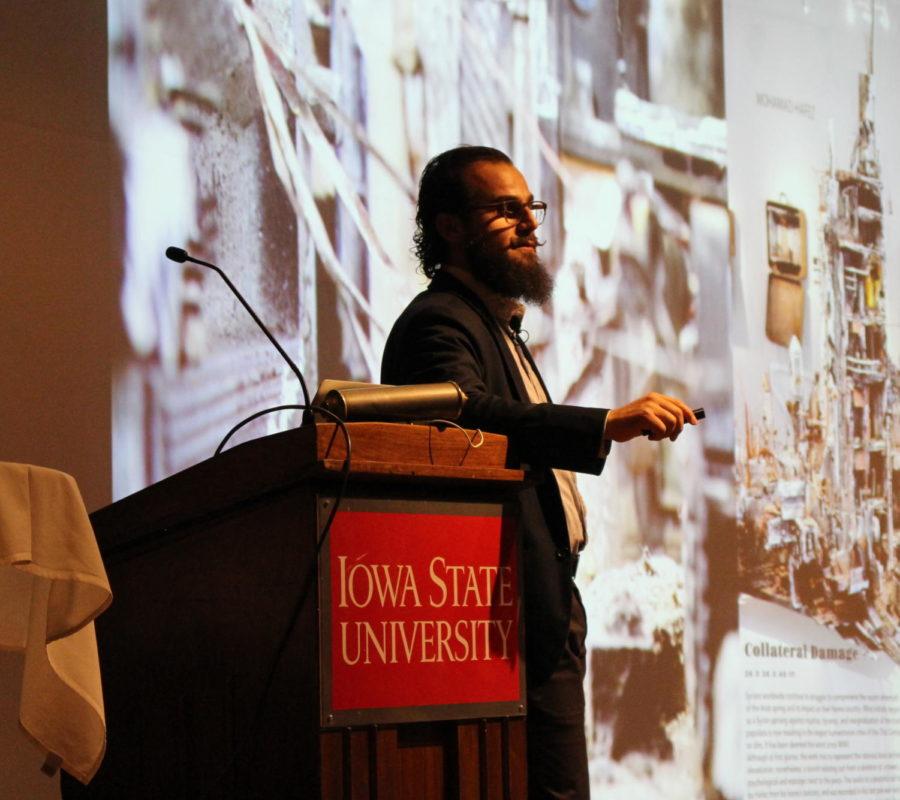Mohamad Hafez offers a new perspective on Syria, refugees and Muslims through storytelling and art
Mohamad Hafez, architecture graduate from Iowa State University, speaks about how he uses his art to recreate a time or memory through a suitcase. Through his art he hopes to humanize the refugee’s plight. This lecture took place in the Memorial Union on Sept. 5.
September 5, 2018
New perspectives and stories regarding the meaning of the terms such as refugee, Syrian and Muslim were brought to Iowa State’s campus Wednesday through Mohamad Hafez, an Iowa State alumnus and nationally acclaimed artist.
Hafez co-created “UNPACKED: Refugee Baggage” with writer and former Iraqi refugee Ahmed Badr. Their exhibition, currently being featured in the Christian Petersen Art Museum in Morrill Hall, uses suitcases containing miniature models created with found objects, paired with the recorded stories of refugees.
Hafez hopes to give new meaning to various odds and ends from old machinery by making them into the miniature models within the suitcases.
Born in Damascus, Syria, Hafez grew up in Saudi Arabia. During his lecture, Hafez spoke about the details of his life and those close him, as well as his art and artistic process. He discussed his upbringing and his family, showing pictures of large family dinners, vacations and his siblings’ times at Iowa State.
“My art was a way for me to speak with my mouth shut,” Hafez said.
When Hafez first began to practice art, it was a therapeutic experience for him to recreate architecture and scenes from Syria, as he was unable to return home due to a Bush-era travel ban and a single-entry student visa.
He said he decided to eventually start making his art public, and over time he was motivated to make it more political due to the destruction and hardships of the Syrian war, and eventually the refugee crisis.
Hafez explained he was first inspired to speak out about refugees in 2014, but that the inspiration for his new focus came when his brother-in-law, sister and their family had to travel by dinghy across the Mediterranean Sea to be relocated as refugees in Sweden.
He also talked about the unity of his neighborhood, saying that if it was ever found out that a family member in the neighborhood was struggling financially, a package of goods would be discreetly dropped at their doorstep at night to help them without potentially damaging their pride.
Hafez said he showed these images and shared his stories with the goal of showing audience members what it means to be Syrian.
Additionally, Hafez challenged perceptions of refugees and women who choose to wear a hijab. He told a story of a woman who founded a secret school for undocumented children who would not have been able to receive an education otherwise.
Hafez also challenged perceptions of refugees in another way by telling a story about his brother-in-law, saying that often refugees are thought to be from small or impoverished areas, or lack education. Hafez’s brother-in-law was both a successful architect and businessman in Damascus.
Hafez said, in the modern age people travel and experience life all over the world.
“The day and age where you live and work and die in one spot, I think, is gone,” Hafez said.
He elaborated further on this belief with his own identity and background.
“Yes I am Syrian. Yes I am Muslim, but I am also very proud to be an American resident,” Hafez said.
Hafez believes that people should not paint millions of people with wide brushstrokes, and that they should recognize that you cannot stamp one label onto the word refugee. He said that he hopes and holds himself to the standard that his work brings people together.







